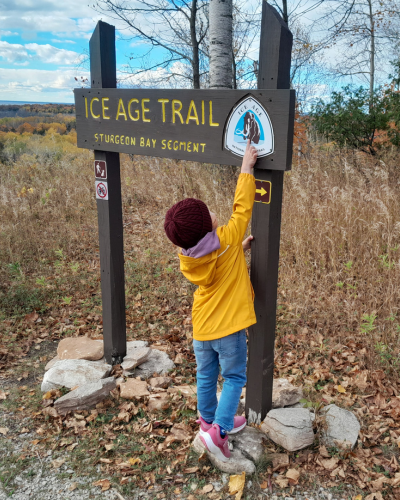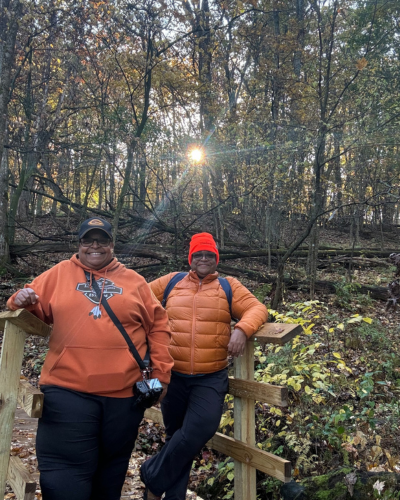
Two Alliance staff members and a dedicated volunteer recently traveled to Washington, D.C. to participate in the American Hiking Society/Partnership for National Trails’ annual “Hike the Hill” event. This gathering brings together national scenic and historic trail representatives to discuss the current state of trails with federal partners and to advocate for the trails with lawmakers.
Going into “Hike the Hill” this year, we knew things would be different. What we didn’t fully grasp was just how challenging the situation had become. The federal government’s mass layoffs, hiring freeze, and funding freezes are having effects nationwide, including on many of the national trails and parks across the country. Hearing the firsthand accounts from our fellow trail organizations was disheartening.
- One trail organization, still waiting on reimbursement for already completed work, is facing staff layoffs.
- Another had to cancel their entire trail-building season.
- A third is scrambling to determine if it will be able to hire a seasonal crew for a season that begins in just two months, with no certainty of funding.
Thanks to the support of Alliance members and Trail supporters, the Ice Age Trail is not currently facing the worst of these impacts. But, make no mistake—our Trail is feeling the effects.


Staff Reductions: A Return to Bare-Bones Operations
The National Park Service (NPS) office that supports the Ice Age National Scenic Trail has always operated with a small but mighty team. Just in the past year, they had reached full staffing with 7.33 people dedicated to supporting a 1,200-mile trail and thousands of volunteers. With clearly defined roles, significant progress was being made.
But now, there’s been a giant step backward. Due to the hiring freeze, early retirement offer, and mass firing of federal employees, just four staff members remain in the Ice Age Trail-NPS office.
The impacts of this staffing reduction are already being felt:
- Remaining NPS staff members now shoulder the work of the vacant positions, prioritizing day-to-day operations over strategic and long-term planning
- Future planning for the Trail is in limbo
- The often-requested Ice Age Trail Junior Ranger program will likely not launch this year
Funding Freezes: What’s at Risk
Approximately 10% of the Ice Age Trail Alliance’s 2025 budget relies on federal funding. While we’ve always been mindful not to rely too heavily on one funding source, losing 10% will have consequences. One of the most immediate impacts would be on volunteers.
Previously approved funding is now frozen, affecting:
- Chainsaw training essential for trail maintenance
- Volunteer support, including safety equipment and basecamp infrastructure
- Habitat restoration projects along the Trail
Aside from direct federal funding, another major concern is the funding freeze at the National Park Foundation (NPF), the congressionally established nonprofit partner of the National Park Service. Like the Ice Age Trail Alliance, NPF is primarily funded through private individuals, foundations, and corporate partners, with a portion of its funding coming from federal sources. NPF funding supports many aspects of the Ice Age Trail Alliance’s work, including the following programs which are now at risk:
- Think Outside (Open Outdoors for Kids) program– educational outreach program that gets 10,000 fourth graders on the Trail every school year
- An Inclusive Storytelling podcast project with the Ho-Chunk Nation
- 2025 Ice Age Trail Crew events (planning for 2026 and beyond will be limited)

Due to the uncertainty facing the Trail and the funding that’s in question, the Alliance is taking a hard look at its programs and the upcoming Trailbuilding seasons. We will adjust our existing plans, as necessary.
Here’s what would happen if we need to reduce the 2025 Ice Age Trail Crew season:
- Fewer new miles of Trail to hike: Plans were in place to build 15 new miles of Trail this year. That number would be drastically reduced if we have to reduce the number of projects.
- Fewer certified volunteers: Crew Leader Training, Chainsaw Training, First Aid/CPR training, and more may not be able to take place this year.
- Slower progress in the future: This year’s Trail layout and design efforts, which set up future Trail construction, will be limited.
- Not enough equipment for volunteers: We may not be able to purchase the equipment and supplies needed for volunteers who want to help out.
Although our progress may slow, one thing is certain: the Alliance will forge ahead to conserve, create, maintain, and promote the Ice Age Trail.

You Can Help: Speak Up for the Trail
Decisions being made in Washington, D.C., directly affect the Ice Age Trail and the Alliance. But there is something you can do: Speak up for the Trail.
Contact your elected officials today. Let them know:
- You care about the Ice Age National Scenic Trail and the National Park Service.
- Previously approved funding should be restored.
- The mass layoffs and hiring freezes at the National Park Service (and other land management agencies) must end.
When we visited congressional and senate offices last week, we heard one clear message from both political parties: They want to hear from their constituents. They need to know how these funding cuts and freezes are affecting the places you love.
Call, email, or write to your representatives. Get their contact information here. Share your support for the Trail. It’s an asset to the state, drives tourism, and has a positive economic impact along its 1,200 miles.
One last thing: if you call, please be kind to the staff answering the phones. They are mostly young professionals doing their jobs.
Together, we can stand up for the future of the Ice Age Trail. Your voice matters—use it!

